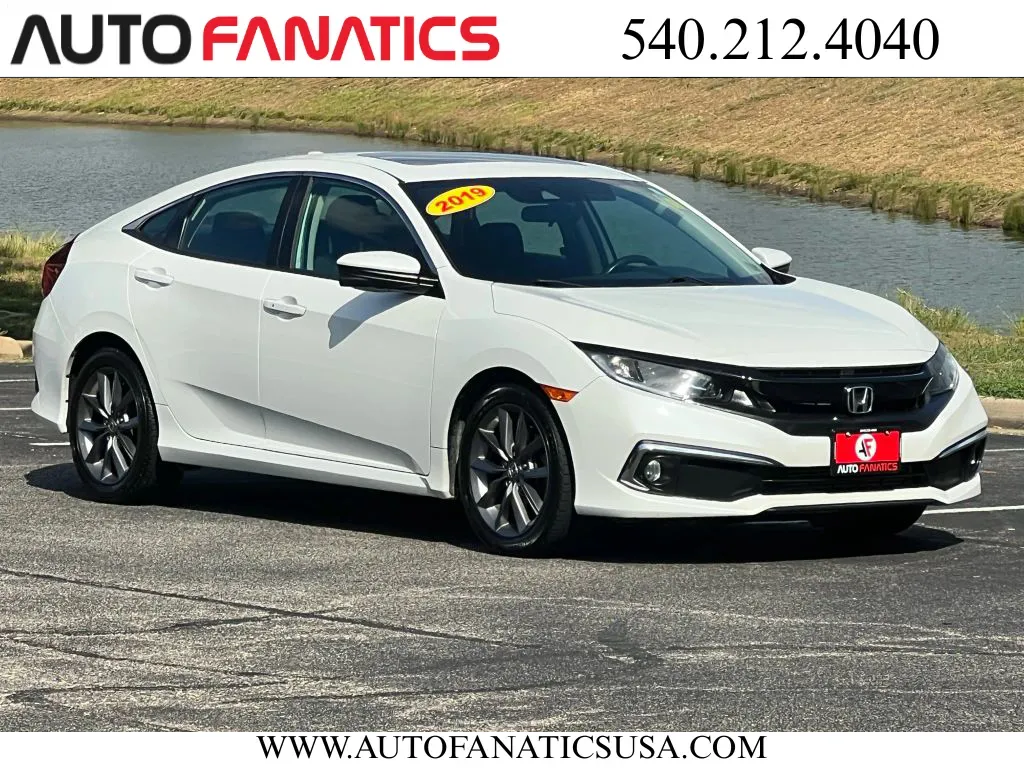How to Get a Great Trade-In Offer: Expert Advice
Table of Contents
How to Get a Great Trade-In Offer: Expert Advice
The value of your car isn’t just a number from a national database; it’s directly tied to the local market. Here in Northern Virginia, the demand for a fuel-efficient sedan versus a rugged, four-wheel-drive truck can change with the seasons and local needs. Understanding what Fredericksburg drivers are currently looking for gives you a significant advantage. As a local dealership, we have our finger on the pulse of this market. We’ll show you how to factor in this local demand, alongside your car’s condition and history, so you can approach the process with a realistic and strategic mindset to get a great trade-in offer.
Key Takeaways
- Arm yourself with data: Before you talk to a dealer, use online tools and check local listings to find your car's true market value. This knowledge is your best tool for ensuring you get a fair and competitive offer.
- Presentation is everything: Increase your car's perceived value by giving it a deep clean and gathering all your service records. A well-presented car with a documented maintenance history shows you've been a responsible owner and can directly lead to a better offer.
- Negotiate the trade-in first: To maintain clarity and control, always agree on your trade-in value as a standalone deal before discussing the price of your next car. This prevents your car's value from getting lost in a bundled payment and ensures you know exactly what you're getting.
What Determines Your Car's Trade-in Value?
When you decide to trade in your car, the offer you receive can feel like a mystery number pulled from thin air. But it’s not random at all. A dealership appraiser looks at a specific set of factors to determine what your car is worth to them. Understanding these key elements demystifies the process and puts you in a much stronger position when you walk into the dealership. Think of it as building a case for your car's value—the more you know, the better you can highlight its strengths.
Each vehicle is unique, and its final trade-in price is a blend of its history, condition, and current market desirability. While you can't change your car's age or the number of miles on the odometer, you have more control over other areas than you might think. By focusing on what you can influence, like its cleanliness and your maintenance records, you can directly impact the offer you get. Before you even start the process, you can get a baseline idea when you get your trade-in value with an online tool.
Age and Mileage
It’s the classic duo of car valuation: age and mileage. Generally, a newer car with fewer miles will command a higher trade-in offer. This is because mileage is a straightforward indicator of wear and tear. A lower number suggests the engine, transmission, and other major components have more life left in them, making the car a more reliable and attractive option for the next owner. Dealerships see this as less risk and a higher potential resale value. However, high mileage isn't always a deal-breaker. A high-mileage vehicle with a flawless maintenance history can still be more valuable than a lower-mileage car that's been neglected.
Make, Model, and Demand
Not all cars are created equal when it comes to holding their value. Certain makes and models have a stronger reputation for reliability and longevity, which helps them retain their worth over time. Beyond brand reputation, local market demand is a huge factor. Here in Virginia, a fuel-efficient sedan might be in high demand for commuters, while spacious SUVs are always popular with families. Dealerships are constantly trying to stock their lots with vehicles they know will sell quickly. If you happen to have a car that’s currently a hot commodity in the Fredericksburg area, you’re in a great position to receive a competitive offer.
Vehicle Condition and Maintenance
This is where you can really make a difference. The physical and mechanical condition of your car is scrutinized during an appraisal. An appraiser will walk around your car, looking for dings, dents, and scratches. They’ll check the tire tread and inspect the interior for stains, tears, or excessive wear. A car that looks clean and well-cared-for immediately makes a better impression. It signals that you’ve likely been diligent with mechanical upkeep, too. Taking the time to fix small issues and giving your car a thorough cleaning shows pride of ownership and can easily add to its perceived value.
Your Service Records
Having proof of regular maintenance is one of the best ways to support your car's value. A neat folder containing service receipts, oil change records, and a clean vehicle history report from a service like CarFax speaks volumes. This documentation shows the appraiser that you’ve taken care of the vehicle and followed the manufacturer's recommended service schedule. It removes guesswork and reduces the dealership's risk, as they have a clear picture of the car's history. Being transparent with these records builds trust and shows you’re a responsible owner, which can often translate into a better trade-in offer.
Local Demand and Seasonality
A car’s value isn’t the same everywhere. Location plays a significant role. For example, a four-wheel-drive truck will likely fetch a better price in an area with tough winters than in a warm, southern climate. Seasonality also matters—convertibles are more desirable in the spring and summer, while all-wheel-drive vehicles are more sought after in the fall and winter. Because we’re a local dealership, we have a pulse on what Fredericksburg drivers are looking for right now. We tailor our used car inventory to meet that demand, which means we’re always looking for quality local trade-ins.
How to Prep Your Car for Trade-In
Putting in a little effort before your trade-in appraisal can make a big difference in the offer you receive. It’s all about presentation and showing the dealership that your vehicle has been well cared for. A car that looks good on the surface suggests it’s also been maintained well under the hood, which can translate directly to a better value for you. Think of it as staging a home before a sale—you’re highlighting its best features. Follow these simple, actionable steps to get your car ready and head to the dealership with confidence.
Give It a Deep Clean
First impressions are everything, and a sparkling clean car immediately looks more valuable. You don’t need to spend a fortune on a professional detail, but a thorough cleaning makes a huge impact. Give the exterior a good wash and a coat of wax to make the paint shine. Don’t forget the wheels and tires! On the inside, go beyond a quick pass with the vacuum. Wipe down the dashboard, door panels, and center console. Clean the windows inside and out, and consider using a mild air freshener to eliminate any lingering odors. A clean car shows pride of ownership and signals to the appraiser that you’ve likely been diligent with its upkeep.
Handle Key Maintenance and Repairs
You don’t need to perform a major overhaul, but fixing small, obvious issues can prevent a lower offer. If there are any warning lights on the dashboard, it’s worth getting them checked out. Replace any burnt-out headlights or taillights and top off all the essential fluids like windshield washer fluid and oil. While it’s usually not cost-effective to fix major mechanical problems right before a trade-in, taking care of these minor items shows the appraiser that the car is in good working order and hasn’t been neglected. It removes easy reasons for the dealer to reduce their offer.
Gather Your Paperwork
Being organized builds trust and provides concrete proof of your car’s history. Collect all your service records in a folder to show you’ve kept up with routine maintenance like oil changes, tire rotations, and brake inspections. If you’ve had any major work done, like a timing belt replacement, be sure to include that receipt. Having the car’s title and registration easily accessible will also streamline the process. Once you have your documents in order, you can get a preliminary estimate online to value your trade and come to the dealership with a solid starting point for your conversation.
Do a Quick Self-Inspection
Take a few minutes to walk around your car and see it from a buyer’s perspective. Look for minor dings or scratches that you might be able to improve with a simple touch-up paint pen from an auto parts store. Check that all your lights are working, including turn signals and brake lights. Also, take a look at your tires—if they are properly inflated and have decent tread, it’s one less thing for an appraiser to note. The goal isn’t to make the car look brand new, but to present it in the best possible light and show that it has been consistently cared for.
Clear Out Your Personal Belongings
Before you head to the dealership, make sure to completely empty your car of all personal items. Go through the glove compartment, center console, door pockets, and trunk. Don’t forget to check under the seats and in any hidden storage compartments. This not only helps the appraiser get a clear and accurate look at the vehicle’s condition but also protects your privacy. Remember to unpair your phone from the Bluetooth system and clear any saved addresses from the navigation. With your car cleaned out and ready, you can focus on the fun part: browsing our wide selection of used cars to find your next ride.
How to Find Your Car's True Value
Before you can negotiate a great deal, you need a realistic idea of what your car is worth. Your car’s "true value" isn't just one number; it's a range based on data, market demand, and its specific condition. Doing a little homework here is the single most important step you can take to ensure you get a fair price. It puts you in the driver's seat during the trade-in conversation by replacing guesswork with facts. Think of it as building your case—the more evidence you have, the stronger your position will be. Let's walk through exactly how to gather that evidence and determine what your car is really worth.
Use Online Valuation Tools
Your first stop should be online valuation tools. Websites like Kelley Blue Book (KBB) and Edmunds provide instant estimates based on your car's make, model, year, mileage, and condition. For the most accurate number, be brutally honest about your vehicle's state. A few scratches, a stained seat, or worn tires all affect the value. It’s also a great idea to get an estimate directly from a dealership. You can get a real offer in minutes using our online trade-in value tool. These online figures give you a solid baseline to start with.
Research Current Market Prices
An online estimate is a great starting point, but you also need to see what similar cars are actually selling for right now, right here in Virginia. Check the listings on local dealership websites and major online marketplaces. Look for cars that are the same year, make, and model as yours, with similar mileage and features. This research shows you the real-world, local market value. Pay attention to how long cars have been listed and if prices have dropped. This gives you a powerful understanding of current market prices and what a dealer might realistically offer.
Get Offers from Multiple Dealerships
Don't take the first offer you get. The best way to confirm your car's value is to see what different buyers are willing to pay for it. Take your car to a few different dealerships in the Fredericksburg area and ask for a written trade-in offer. You can also get instant online offers from national retailers like CarMax or Carvana. Having multiple offers in hand gives you incredible leverage. You can confidently walk into a negotiation knowing the highest price someone is willing to pay. We make it easy to sell us your car outright, even if you don't buy from us, giving you another no-pressure offer to consider.
Consider the Timing of Your Trade-In
While it’s not something you can always control, timing can play a role in your car's value. Demand for certain vehicles fluctuates with the seasons. For example, convertibles are more popular in the spring, while SUVs and trucks are in high demand before winter. Dealerships are always looking for quality used cars to fill their lots because they are a key part of their business. While you can’t perfectly time the market, being aware that your vehicle might be more desirable at certain times of the year can be a small but helpful piece of knowledge during your trade-in process.
Factor in Your Location
Where you live matters. A vehicle's value can change significantly from one region to another based on local demand and even the weather. A four-wheel-drive truck or SUV is often more valuable in Northern Virginia, where we see all four seasons, than it might be in a warmer, flatter state. That's why getting competitive quotes from dealers in your specific area—like Fredericksburg, Stafford, or Spotsylvania—is so important. National averages are helpful, but a local price from a dealer who understands the local market is the most accurate reflection of your car's worth.
How to Negotiate Your Trade-In Offer
Walking into a negotiation can feel intimidating, but it doesn't have to be. With the right preparation, it’s simply a conversation to agree on a fair price for your vehicle. Think of it as a business transaction where you’re the seller. When you’re prepared and confident, you can work with the dealership to land on a number that feels right for everyone. The key is to focus on clear, separate steps to make the process smooth and successful.
Discuss the Trade-In Separately
One of the most effective strategies is to treat your trade-in as its own distinct deal. Some dealerships may try to roll the trade-in value, the price of your next car, and your financing terms into a single monthly payment. While this might seem simple, it can make it difficult to see how much you’re actually getting for your trade. To keep things clear, state upfront that you’d like to settle on the trade-in value first. By establishing what the dealership will pay for your car before you discuss your next purchase, you can negotiate from a position of clarity and strength.
Leverage Other Offers
Knowledge is power, and in this case, that knowledge comes from knowing what your car is worth on the open market. Before you visit the dealership, get a few offers from other places. Online car buyers and other dealerships can give you competing quotes that serve as a powerful reference point. This isn't about creating a confrontation; it's about having a realistic, data-backed understanding of your car's value. When you can say, "I received another offer for X amount," it grounds the conversation in facts. You can start this process right now by getting a baseline estimate with an online trade-in valuation tool.
Present All Your Documentation
The best way to support your asking price is with proof. Arrive at the dealership with a folder containing all your vehicle’s important paperwork. This includes detailed service records, receipts for any recent major repairs or new tires, and a current vehicle history report. This documentation demonstrates that you’ve been a diligent owner and that your car has been well cared for. It shifts the conversation from subjective opinions about the car's condition to objective facts. Showing a clean maintenance history can directly translate into a better offer because it reduces the risk for the dealership. It shows you share the same commitment to transparency that we value in our customer relationships.
Understand How Dealers Value Trades
It’s helpful to see the transaction from the dealer's perspective. A dealership is looking at the profitability of the entire deal, not just the trade-in. This means the amount they offer for your trade is connected to the price of the car you’re buying. For example, a dealership might present a very high trade-in value but be less flexible on the price of your next vehicle, or vice versa. Your goal is to secure a great overall value. By understanding that these two figures are related, you can better assess the final deal and ensure it works for your budget. Our customers often mention feeling they received a fair, holistic deal in their reviews.
Know When to Walk Away
Your greatest strength in any negotiation is your ability to walk away. It’s easy to get excited about a specific car you’ve found, but it’s important not to let that emotion cloud your judgment. If the final offer on your trade-in doesn't align with your research and your financial goals, it is perfectly acceptable to politely decline and leave. A no-pressure dealership will respect your decision. Remember, there are always other options out there. Keeping a level head and being prepared to explore other vehicles in our inventory ensures you’ll only accept a deal that you feel genuinely good about.
Common Trade-In Mistakes to Avoid
Trading in your car should be a straightforward and rewarding process, but a few common missteps can prevent you from getting the best possible offer. By being aware of these pitfalls, you can approach the trade-in with confidence and ensure you receive a fair value for your vehicle. The goal is to make the transaction smooth and transparent, setting you up for success with your next car purchase. Let’s walk through the mistakes to steer clear of so you can feel great about your deal.
Skipping Your Research
Walking into a dealership without knowing your car's value is like going to a job interview without knowing the typical salary for the role. You're putting yourself at a disadvantage from the start. Before you even think about trading in, you need a solid idea of what your car is worth. Use online resources like Kelley Blue Book to get a baseline estimate. For a more concrete number, you can get your trade-in value directly from us. Having a realistic number in mind based on your car’s specific details—like mileage, condition, and features—gives you a powerful starting point for any conversation.
Neglecting Your Car's Condition
First impressions matter, and that’s just as true for your car as it is for anything else. A vehicle that looks well-cared-for suggests it has been well-maintained. Before you bring it in for an appraisal, give it a thorough cleaning inside and out. Vacuum the carpets, wipe down the surfaces, and run it through a car wash. Don’t forget to remove all your personal belongings. While you don’t need to fix every minor scratch, taking care of small, inexpensive repairs can make a big difference. A clean, tidy car signals to the appraiser that you’ve been a responsible owner, which can positively influence your offer.
Forgetting Important Documents
Having your paperwork in order makes the trade-in process much smoother and can even strengthen your position. Gather all your service and maintenance records to show a clear history of how well you’ve cared for the vehicle. If you have a vehicle history report from a service like CarFax, bring that along, too. Most importantly, make sure you have the car’s title handy, as you can’t trade in a vehicle without it. Presenting a complete and organized folder of documents builds trust and shows that you’re a serious and prepared seller, leaving less room for doubt or lowball offers.
Negotiating Without a Plan
One of the easiest ways to lose value in a trade-in is by blending it with the negotiation for your new car. Some dealerships may try to bundle everything into one monthly payment, which can make it confusing to see how much you’re actually getting for your trade. Your best strategy is to treat them as two separate transactions. First, agree on a firm price for your trade-in. Then, you can discuss the price of the car you want to buy. Using a car loan calculator beforehand can also help you understand your budget and keep the financing conversation separate.
Rushing the Decision
The car-buying process can be exciting, and it’s easy to get caught up in the moment when you find a vehicle you love. However, feeling pressured or rushing into a decision is a mistake. If a trade-in offer seems too low, don’t be afraid to say so and be prepared to walk away. Patience is your best friend. Having other offers or a solid valuation from your research gives you the confidence to stand firm. A reputable dealership will respect your position and work with you to find a fair solution. Remember, you are in control of the transaction.
Related Articles
Frequently Asked Questions
What if my car has high mileage? Is it still worth trading in? Absolutely. While lower mileage is generally preferred, a high-mileage car with a consistent and well-documented service history can be very valuable. It shows the vehicle has been reliable and cared for. We look at the whole picture, and proof of regular maintenance often speaks louder than the number on the odometer.
Should I fix a major dent or a mechanical issue before I bring my car in? For major repairs, it's usually best to hold off. You will rarely get back the full amount you spend on a significant repair in the form of a higher trade-in offer. Dealerships can typically handle these repairs more cost-effectively. Your energy is better spent on a thorough cleaning and gathering your service records, which can improve the offer without a large investment.
What if the dealership's offer is lower than the online estimates I found? Online valuation tools are excellent for getting a general idea of your car's worth, but they are just estimates. A dealership's offer is a firm, real-world price based on a physical inspection, your car's specific condition, and current local market demand. If an offer seems low, this is a great time to present your service records and any competing offers you've received to support a higher value.
Can I trade in a car that I still owe money on? Yes, this is very common. We handle the process by contacting your lender to get the exact payoff amount. If your car's trade-in value is more than what you owe, the extra money is applied as a down payment on your next vehicle. If you owe more than the car is worth, we can help you explore options for rolling that amount into your new auto loan.
Do I have to buy a car from you to get a trade-in offer? Not at all. We are always looking to add quality vehicles to our inventory. We will happily appraise your car and make you a competitive offer to buy it from you outright, whether you plan on purchasing your next car from us or not. There’s no pressure and no obligation.










